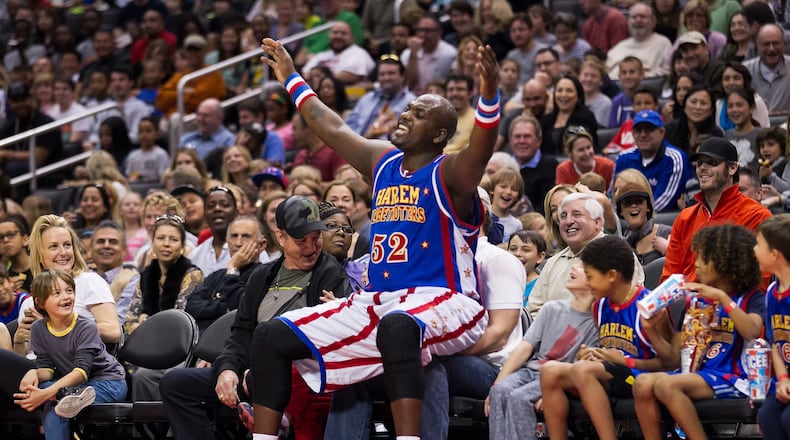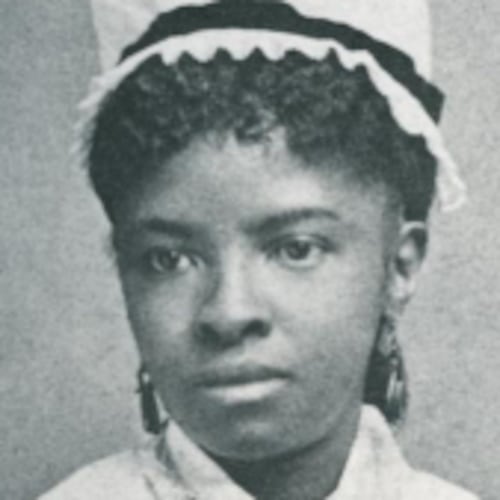The Harlem Globetrotters was a bit of an overstatement in its earliest days.
The team didn’t cover the world. Its Black players traveled to tiny, predominantly white towns in Iowa, the Dakotas and elsewhere in the Midwest. And the Globetrotters, now based in Peachtree Corners, weren’t from Harlem.
But issues of race were often tangled up in its more than 90-year basketball history, for good and ill.
Before countless half-court shots, basketballs spinning on fingers, shenanigans involving buckets of confetti, referees enduring gags that involved their pants being yanked down, even before Black players danced on court with white women when such things would have been considered risky in the outside world, the Globetrotters were focused on great basketball.
Twice in the late 1940s they beat the best team in what was then an all-white NBA, with two future Hall of Famers opposing them.
“The fact that the Trotters could beat them in regular basketball showed the quality of basketball that Black players were playing, or capable of playing, had they been given more opportunities,” said Ron Thomas, who authored the book “They Cleared the Lane: The NBA’s Black Pioneers” and is director of Morehouse College’s journalism and sports program.
Credit: Harlem Globetrotters
Credit: Harlem Globetrotters
In 1950, the NBA let in its first Black players, including Globetrotter Nat “Sweetwater” Clifton, who became the first to sign an NBA contract.
The Globetrotters launched in the 1920s, an all-Black team from Chicago, started by Tommy Brookins, a Black basketball player and jazz singer, according to Ben Green, who wrote the book “Spinning the Globe: The Rise, Fall and Return to Greatness of the Harlem Globetrotters.”
Abe Saperstein, a white booking agent, soon took over the business. The Globetrotters rumbled into 150 Midwest towns a year to take on the best local teams they could find.
“A lot of times it was the first interaction that a lot of white people ever had with Black athletes and maybe with African Americans in general,” Green said.
Credit: Harlem Globetrotters
Credit: Harlem Globetrotters
The team dominated white opponents. So the Globetrotters added gags and ball-handling tricks in the middle of games. The shift gave players a breather and limited the margins of their victories, increasing the odds that they might be booked for return visits.
Even early on, the clowning sparked controversy. The owner of the New York Rens, another powerhouse Black team, accused the Globetrotters of being Uncle Toms who were performing minstrel shows full of demeaning racial stereotypes, Green said.
Nonetheless, the Globetrotters became the stronger and better known team. In a 1953 column, an Atlanta Constitution sports editor described the Globetrotters as “the most watched athletic team in the world.”
Saperstein tried to keep the near-monopoly he had on the nation’s best Black players and initially fought NBA plans to integrate, Green said. Later, future Hall of Famers Reece “Goose” Tatum and Marques Haynes complained Saperstein underpaid them.
Credit: Harlem Globetrotters
Credit: Harlem Globetrotters
Still, the Globetrotters managed to land talented athletes, including future NBA star Wilt Chamberlain.
Players such as Meadowlark Lemon and Curly Neal gained worldwide fame. Later, the team was regularly featured on ABC’s popular Wide World of Sports and Saturday morning cartoons. It also toured overseas.
Credit: Harlem Globetrotters
Credit: Harlem Globetrotters
For much of the team’s history, though, players were confronted with the same racism as other Black people.
Mannie Jackson, who played for the Globetrotters in the early 1960s, recalled them being blocked from Southern hotels and restaurants. Often, they played in segregated arenas.
“Black, young men would go around the world to represent a country that didn’t care about them except as entertainment,” said Jackson. Nonetheless, he added, the Globetrotters “have been one of the greatest ambassadors of the possibilities of this country.”
Jackson later become a Honeywell executive and, in 1993, bought and rebuilt the Globetrotters as it teetered on financial collapse.
Credit: Brett D. Meister
Credit: Brett D. Meister
The team is owned now by Gwinnett County-based Herschend Enterprises, which operates properties such as Dollywood, Callaway Gardens and Stone Mountain Park, with its giant carving of Confederate figures.
Before being sidelined by the pandemic, the Globetrotters played about 450 games annually, relying on 30 players spread over multiple teams. The team, which included some players of different races, said it was drawing more than 2 million fans a year.
Globetrotters coach “Sweet Lou” Dunbar recalled growing up in segregated Louisiana and watching the team.
“You have to give homage to those guys for all the sacrifices they went through,” he said.
BLACK HISTORY MONTH: Throughout February, we’ll spotlight different African American pioneers ― through new stories and our archive collection ― in our Living and Metro sections Monday through Sunday. Go to AJC.com/black-history-month for more subscriber exclusives on people, places and organizations that have changed the world, and to see videos on the African American pioneers featured here each day.
About the Author
The Latest
Featured








